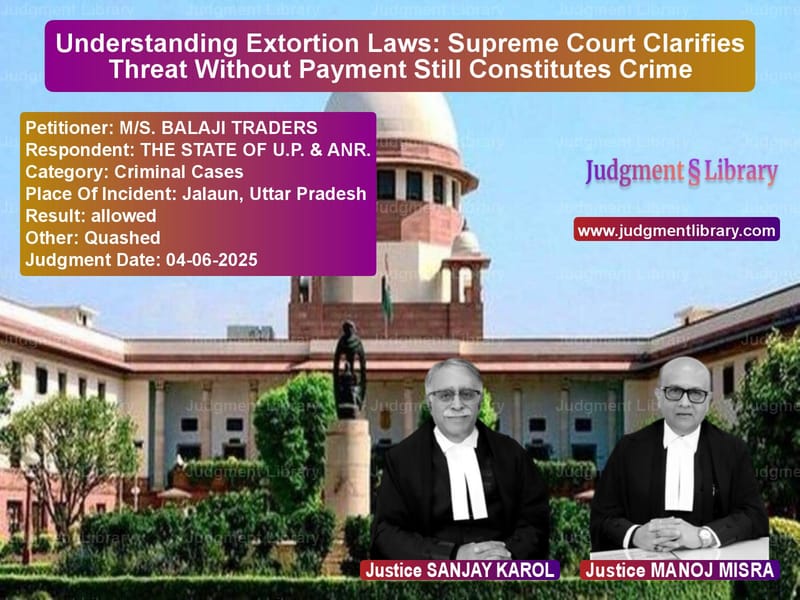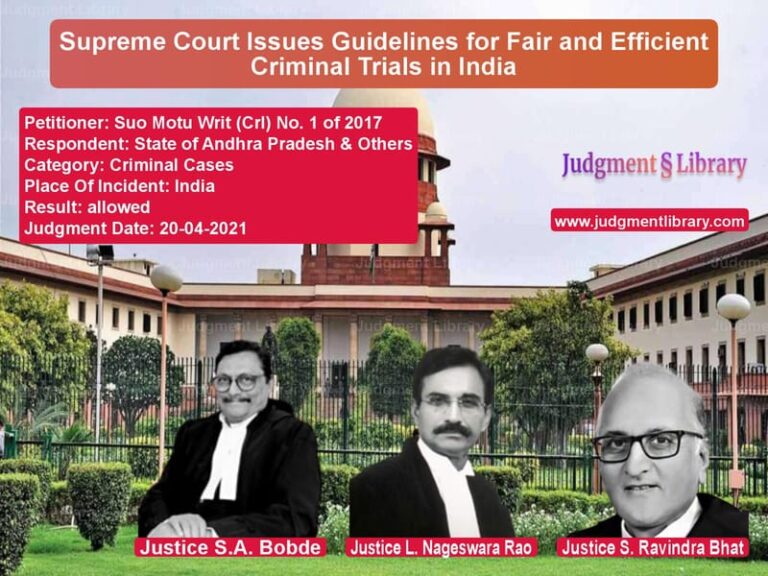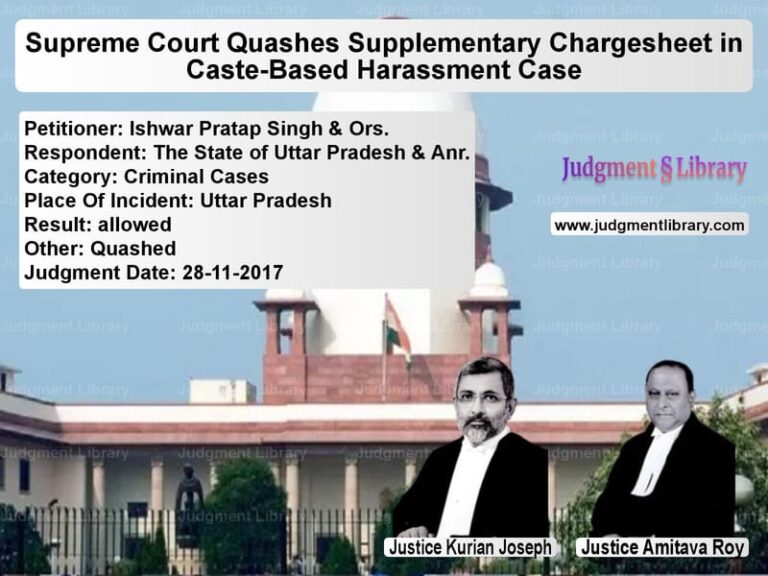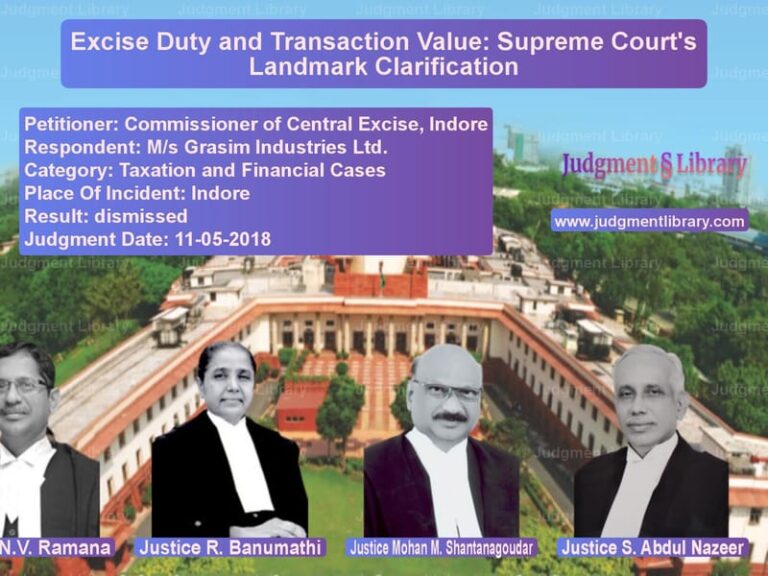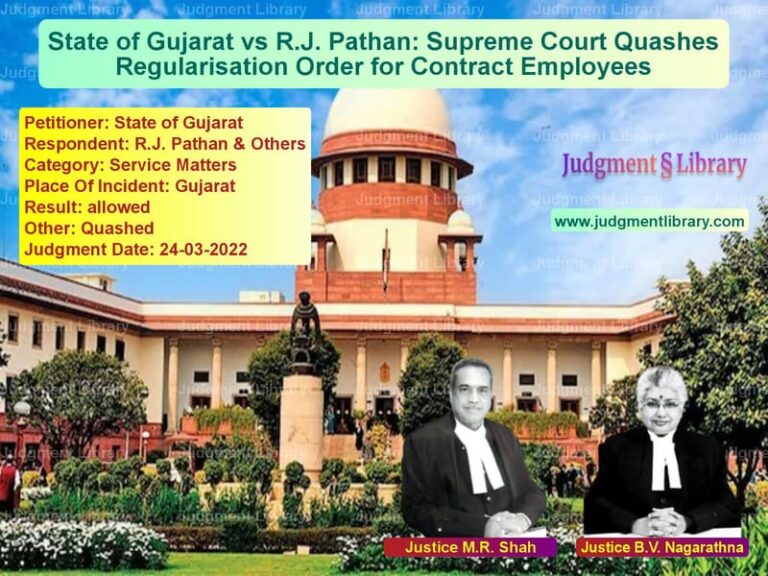Understanding Extortion Laws: Supreme Court Clarifies Threat Without Payment Still Constitutes Crime
In a significant judgment that clarifies the interpretation of India’s extortion laws, the Supreme Court recently delivered a ruling that has far-reaching implications for how criminal threats are treated under the Indian Penal Code. The case involved a business dispute that escalated into criminal allegations, ultimately requiring the highest court to determine what exactly constitutes the crime of extortion when no property actually changes hands.
The story begins with Prof. Manoj Kumar Agrawal, proprietor of M/s. Balaji Traders, who operated a betel nut leaves business. According to his complaint, on May 22, 2022, while he was heading towards his house, his business rival Sanjay Gupta along with three unknown persons carrying rifles stopped and threatened him. They allegedly demanded that he close down his betel nut business or pay five lakh rupees per month to continue operations. When Prof. Agrawal refused, the accused persons not only beat him but also attempted to kidnap him.
When the police failed to register a First Information Report, Prof. Agrawal approached the court by filing a complaint under Section 200 of the Code of Criminal Procedure, 1973. The Trial Court, after analyzing the oral and documentary evidence, found a prima facie case against the accused person and issued summons under Section 387 of the Indian Penal Code.
However, the accused person challenged this summoning order before the High Court of Judicature at Allahabad. The High Court, in its judgment dated June 28, 2024, quashed both the summoning order and the entire proceedings of the complaint case. The High Court’s reasoning centered on one crucial point: to make out a case of extortion, one essential ingredient is the delivery of property or valuable security under threat, and since no money was actually handed over to the accused person in this case, the offence of extortion wasn’t made out.
The Legal Battle Reaches the Supreme Court
Aggrieved by the High Court’s decision, M/s. Balaji Traders approached the Supreme Court. The petitioner’s counsel argued that the Trial Court had rightly issued summons based on the statements of witnesses and the complainant. They contended that the High Court had erroneously relied on judgments dealing with Section 384 IPC rather than Section 387 IPC, which was the actual section under consideration.
The respondent’s counsel, however, presented a different perspective. Relying on Dhananjay @ Dhandhanjay Kumar Singh v. State of Bihar, they submitted that since the essential ingredient of extortion – delivery of property – was not met, the charge under Section 387 IPC could not be sustained. They argued that the respondent was running a similar business to the complainant and had lodged an FIR against the complainant, suggesting that the instant case was a counterblast to the respondent’s lawful actions of enforcing his Intellectual Property Rights.
The respondent’s counsel further relied on several landmark cases including State of Haryana v. Bhajan Lal and Inder Mohan Goswami v. State of Uttaranchal, submitting that criminal prosecution should not be used as an instrument of harassment or for seeking personal vendetta with ulterior motives. Quoting from Motibhai Fulabhai Patel & Co. v. R. Prasad, Dilip Kumar Sharma v. State of M.P., and Tolaram Relumal v. State of Bombay, they emphasized that penal statutes must be construed strictly, and Section 387 IPC as an aggravated form of extortion cannot be stretched to cover mere threats without any delivery of property.
The Supreme Court’s Analysis of Extortion Laws
Before delving into the facts of the case, the Supreme Court bench comprising Justice Sanjay Karol and Justice Manoj Misra examined the legal provisions governing extortion in the Indian Penal Code. The Court reproduced the relevant sections from Chapter XVII of IPC, which define extortion and prescribe punishments for various forms of this offence.
The Court made a crucial distinction that would become central to its judgment: “A glance over all the Sections related to extortion would reveal a clear distinction being carried out between the actual commission of extortion and the process of putting a person in fear for the purpose of committing extortion.”
The Court explained that Section 383 defines extortion, while Section 384 prescribes its punishment. Sections 386 and 388 provide for aggravated forms of extortion. These sections deal with the actual commission of extortion. In contrast, Sections 385, 387 and 389 IPC seek to punish acts committed for the purpose of extortion, even when the act of extortion may not be complete and property not delivered.
Justice Karol, writing for the bench, articulated this distinction with precision: “Section 387 IPC provides for a stage prior to committing extortion, which is putting a person in fear of death or grievous hurt ‘in order to commit extortion’, similar to Section 385 IPC. Hence, Section 387 IPC is an aggravated form of 385 IPC, not 384 IPC.”
Essential Ingredients of the Offences
The Court then examined the essential ingredients of both Section 383 IPC (extortion) and Section 387 IPC (putting person in fear of death or grievous hurt to commit extortion). For Section 383 IPC, the essential ingredients as laid down in R.S. Nayak v. A.R. Antulay are: (i) the accused must put any person in fear of injury to that person or any other person; (ii) the putting of a person in such fear must be intentional; (iii) the accused must thereby induce the person so put in fear to deliver to any person any property, valuable security or anything signed or sealed which may be converted into a valuable security; and (iv) such inducement must be done dishonestly.
However, for Section 387 IPC, the Court identified only two essential ingredients: (a) the accused must have put a person in fear of death or grievous hurt; and (b) such an act must have been done in order to commit extortion.
The Court emphasized the significance of the phrase ‘in order to’, defining it as “for the purpose of” or “with the purpose of doing”. The bench observed: “‘in order to commit extortion’ clearly reveals that it is in the process of committing the offence of extortion.”
This interpretation led the Court to a significant conclusion: “Thus, it can be said in terms of Sections 386 (an aggravated form of 384 IPC) and 387 IPC that the former is an act in itself, whereas the latter is the process; it is a stage before committing an offence of extortion. The Legislature was mindful enough to criminalize the process by making it a distinct offence. Therefore, the commission of an offence of extortion is not sine qua non for an offence under this Section. It is safe to deduce that for prosecution under Section 387 IPC, the delivery of property is not necessary.”
Precedents Supporting the Interpretation
The Supreme Court reinforced its interpretation by referring to previous judgments where convictions under Section 387 IPC were upheld even when no property was actually delivered. In Radha Ballabh v. State of U.P., the Court dealt with a case where ransom was demanded for releasing a child but no ransom was extorted. The conviction was correctly made under Section 387 IPC.
Similarly, in Gursharan Singh v. State of Punjab, the Court upheld the conviction under Section 387 IPC where money extorted was not paid. Most significantly, in Somasundaram v. State, a three-Judge Bench upheld the conviction under Section 387 IPC where the deceased was tied with an iron chain and rope to a cot and threatened to part with crores of rupees or else execute documents in their favor. Even though there was no delivery of property, the conviction was upheld with the observation that Section 387 IPC is a heightened, more serious form of the offence of extortion in which the victim is put in fear of death or grievous hurt.
Principles of Quashing Criminal Proceedings
The Court also addressed the fundamental principles governing the quashing of criminal cases. Referring to B.N. John v. State of U.P., which reiterated the principles laid down in Bhajan Lal, the Court emphasized that the power to quash should be exercised sparingly. Quoting from Neeharika Infrastructure (P) Ltd. v. State of Maharashtra, a three-Judge Bench decision, the Court highlighted: “The power of quashing should be exercised sparingly with circumspection, in the ‘rarest of rare cases’… Quashing of a complaint/FIR should be an exception and a rarity than an ordinary rule.”
The Court also addressed the principle of strict interpretation of penal statutes, referring to Tolaram Relumal, M. Narayanan Nambiar v. State of Kerala, and Dilip Kumar Sharma. However, the Court clarified that while penal statutes must be strictly interpreted, this doesn’t mean reading additional conditions into a provision that the legislature hasn’t included.
Justice Karol observed: “The scope of the provision cannot be extended by reading into it words which are not there. Section 387 IPC, being a penal provision, has to be strictly interpreted, and no condition/essential ingredient can be read into it that the Statute/Section does not prescribe.”
The Supreme Court’s Final Ruling
After this comprehensive legal analysis, the Supreme Court found the High Court’s reasoning to be fundamentally flawed. The Court stated: “The reasoning adopted by the High Court is, on the face of it, flawed and misplaced. When the Legislature has created two separate offences with distinct ingredients and punishments, then assigning the essential ingredient of one to another is not a correct approach adopted by the High Court.”
The Court elaborated: “Nowhere does the Section say that extortion has to be committed while putting a person in fear of death or grievous hurt. Instead, it is the other way around, that is to say, putting a person in fear of death or grievous hurt to commit extortion. Extortion is not yet committed; it is in the process of committing it that a person is put in fear. Putting a person in fear would make an accused guilty of an offence under Section 387 IPC; it need not satisfy all the ingredients of extortion provided under Section 383 IPC.”
The Supreme Court concluded that the High Court had erred in relying on Dhananjay (supra) as that case dealt with Section 384 IPC, not Section 387 IPC, and was therefore distinguishable.
Without going into the merits of the case itself, the Supreme Court held that this was not a fit case for quashing as the two essential ingredients for prosecution under Section 387 IPC were prima facie disclosed in the complaint: (a) that the complainant had been put in fear of death by pointing a gun towards him; and (b) that it was done to pressurize him to deliver Rs. 5 lakhs.
The Court emphasized: “The High Court, while quashing, has wrongly emphasized the fact that the said amount was not delivered; it failed to consider whether the money/property was delivered or not, is not even necessary as the accused is not charged with Section 384 IPC. The allegations of putting a person in fear of death or grievous hurt would itself make him liable to be prosecuted under Section 387 IPC.”
Accordingly, the Supreme Court allowed the appeal, set aside the High Court’s order, and restored the proceedings before the Trial Court. The parties were directed to appear before the Trial Court on August 12, 2025, with directions for expedited hearing and full cooperation from both sides.
This judgment serves as an important clarification of India’s extortion laws, establishing that the crime of putting a person in fear of death or grievous hurt to commit extortion is complete even if no property actually changes hands. The ruling reinforces that criminal law punishes not only successful crimes but also the process of attempting to commit them, particularly when such attempts involve threats to life and safety.
Petitioner Name: M/S. BALAJI TRADERS.Respondent Name: THE STATE OF U.P. & ANR..Judgment By: Justice SANJAY KAROL, Justice MANOJ MISRA.Place Of Incident: Jalaun, Uttar Pradesh.Judgment Date: 04-06-2025.Result: allowed.
Don’t miss out on the full details! Download the complete judgment in PDF format below and gain valuable insights instantly!
Download Judgment: ms.-balaji-traders-vs-the-state-of-u.p.-&-supreme-court-of-india-judgment-dated-04-06-2025.pdf
Directly Download Judgment: Directly download this Judgment
See all petitions in Extortion and Blackmail
See all petitions in Judgment by Sanjay Karol
See all petitions in Judgment by Manoj Misra
See all petitions in allowed
See all petitions in Quashed
See all petitions in supreme court of India judgments June 2025
See all petitions in 2025 judgments
See all posts in Criminal Cases Category
See all allowed petitions in Criminal Cases Category
See all Dismissed petitions in Criminal Cases Category
See all partially allowed petitions in Criminal Cases Category

